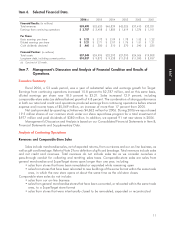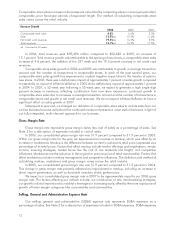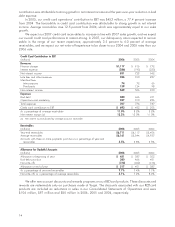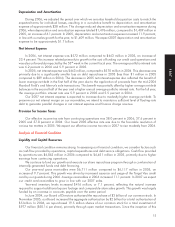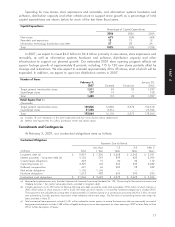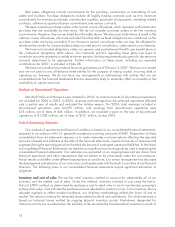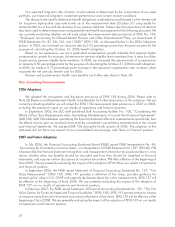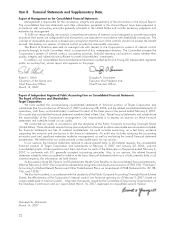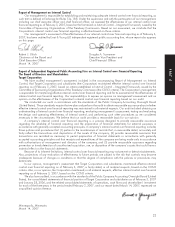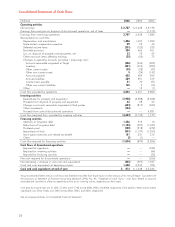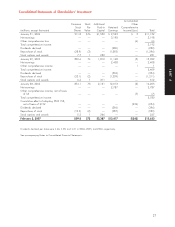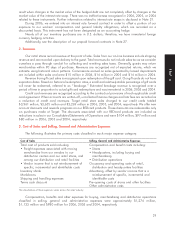Target 2006 Annual Report Download - page 38
Download and view the complete annual report
Please find page 38 of the 2006 Target annual report below. You can navigate through the pages in the report by either clicking on the pages listed below, or by using the keyword search tool below to find specific information within the annual report.Our expected long-term rate of return on plan assets is determined by the composition of our asset
portfolio, our historical long-term investment performance and current market conditions.
The discount rate used to determine benefit obligations is adjusted annually based on the interest rate
for long-term high-quality corporate bonds as of the measurement date (October 31) using yields for
maturities that are in line with the duration of our pension liabilities. Historically, this same discount rate has
also been used to determine pension and postretirement health care expense for the following plan year. We
are currently evaluating whether we will early adopt the measurement date provisions of SFAS No. 158,
‘‘Employers’ Accounting for Defined Benefit Pension and Other Postretirement Plans, an amendment of
FASB Statements No. 87, 88, 106, and 132(R)’’ (SFAS 158), as discussed below in the 2006 Adoptions
section. In 2006, we increased our discount rate by 0.05 percentage points from the previous year for the
purpose of calculating the October 31, 2006 benefit obligation.
Based on our experience, we use a graduated compensation growth schedule that assumes higher
compensation growth for younger, shorter-service pension-eligible team members than it does for older,
longer-service pension-eligible team members. In 2006, we increased the assumed rate of compensation
increase by 0.50 percentage points for the purpose of calculating the October 31, 2006 benefit obligation.
In 2005, we made a 0.75 percentage point increase in the assumed compensation rate increase, which
impacted the net periodic benefit cost for 2006.
Pension and postretirement health care benefits are further described in Note 28.
New Accounting Pronouncements
2006 Adoptions
We adopted the recognition and disclosure provisions of SFAS 158 during 2006. Please refer to
Note 28 (Pension and Postretirement Health Care Benefits) for further description of this adoption. We are
currently evaluating whether we will adopt the SFAS 158 measurement date provisions in 2007 or 2008,
including the potential impact on our results of operations and financial position.
In September 2006, the SEC staff published Staff Accounting Bulletin No. 108, ‘‘Considering the
Effects of Prior Year Misstatements when Quantifying Misstatements in Current Year Financial Statements’’
(SAB 108). SAB 108 addresses quantifying the financial statement effects of misstatements, specifically, how
the effects of prior year uncorrected errors must be considered in quantifying misstatements in the current
year financial statements. We adopted SAB 108 during the fourth quarter of 2006. The adoption of this
statement did not have any impact on our consolidated net earnings, cash flows or financial position.
2007 and Future Adoptions
In July 2006, the Financial Accounting Standards Board (FASB) issued FASB Interpretation No. 48,
‘‘Accounting for Uncertainty in Income Taxes—an interpretation of FASB Statement No. 109’’ (FIN 48). FIN
48 prescribes the financial statement recognition and measurement criteria for tax positions taken in a tax
return, clarifies when tax benefits should be recorded and how they should be classified in financial
statements, and requires certain disclosures of uncertain tax matters. FIN 48 is effective at the beginning of
fiscal 2007. We are presently evaluating the impact of the adoption of FIN 48 on our results of operations
and financial position.
In September 2006, the FASB issued Statement of Financial Accounting Standards No. 157, ‘‘Fair
Value Measurement’’ (SFAS 157). SFAS 157 provides a definition of fair value, provides guidance for
measuring fair value in U.S. GAAP and expands disclosures about fair value measurements. SFAS 157 will
be effective at the beginning of fiscal 2008. We are presently evaluating the impact of the adoption of
SFAS 157 on our results of operations and financial position.
In February 2007, the FASB issued Statement of Financial Accounting Standards No. 159, ‘‘The Fair
Value Option for Financial Assets and Financial Liabilities’’ (SFAS 159). SFAS 159 permits entities to choose
to measure many financial instruments and certain other items at fair value. SFAS 159 will be effective at the
beginning of fiscal 2008. We are presently evaluating the impact of the adoption of SFAS 159 on our results
of operations and financial position.
20



